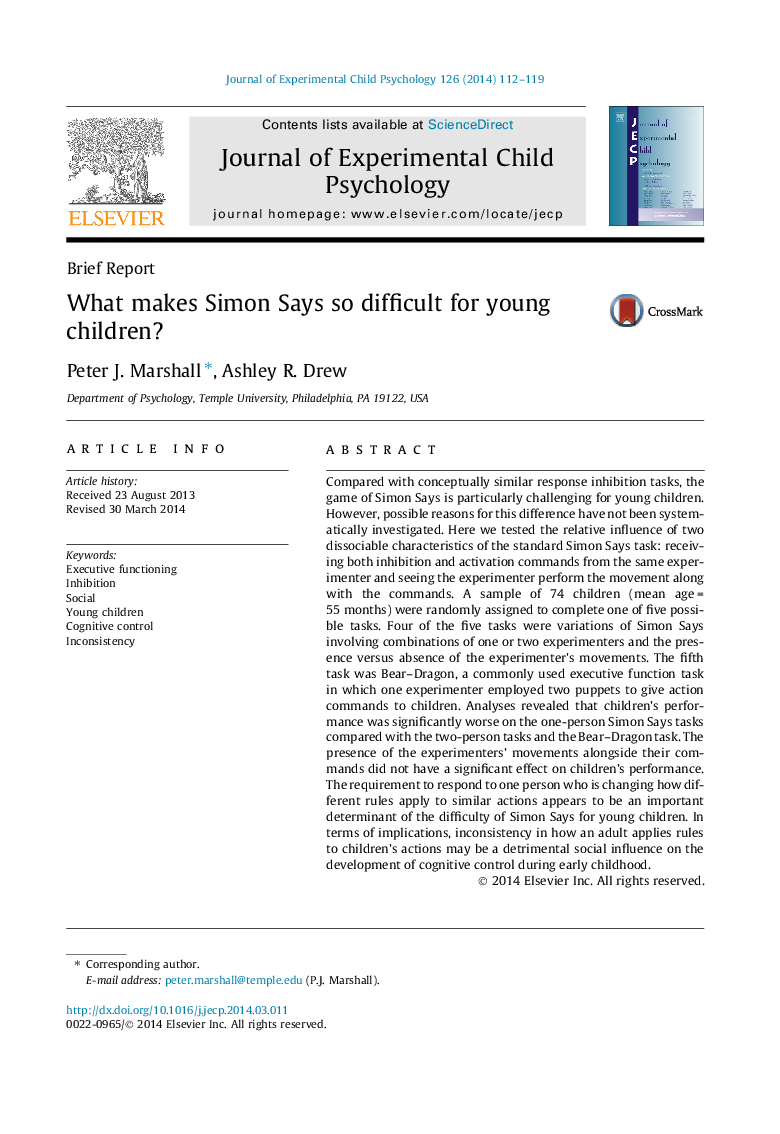| کد مقاله | کد نشریه | سال انتشار | مقاله انگلیسی | نسخه تمام متن |
|---|---|---|---|---|
| 7275324 | 1473486 | 2014 | 8 صفحه PDF | دانلود رایگان |
عنوان انگلیسی مقاله ISI
What makes Simon Says so difficult for young children?
ترجمه فارسی عنوان
چه چیزی باعث می شود سیمون برای بچه های کوچک خیلی دشوار است؟
دانلود مقاله + سفارش ترجمه
دانلود مقاله ISI انگلیسی
رایگان برای ایرانیان
کلمات کلیدی
عملکرد اجرایی، بازداری، اجتماعی، بچه های جوان، کنترل شناختی، تناقض،
موضوعات مرتبط
علوم انسانی و اجتماعی
روانشناسی
روانشناسی رشد و آموزشی
چکیده انگلیسی
Compared with conceptually similar response inhibition tasks, the game of Simon Says is particularly challenging for young children. However, possible reasons for this difference have not been systematically investigated. Here we tested the relative influence of two dissociable characteristics of the standard Simon Says task: receiving both inhibition and activation commands from the same experimenter and seeing the experimenter perform the movement along with the commands. A sample of 74 children (mean age = 55 months) were randomly assigned to complete one of five possible tasks. Four of the five tasks were variations of Simon Says involving combinations of one or two experimenters and the presence versus absence of the experimenter's movements. The fifth task was Bear-Dragon, a commonly used executive function task in which one experimenter employed two puppets to give action commands to children. Analyses revealed that children's performance was significantly worse on the one-person Simon Says tasks compared with the two-person tasks and the Bear-Dragon task. The presence of the experimenters' movements alongside their commands did not have a significant effect on children's performance. The requirement to respond to one person who is changing how different rules apply to similar actions appears to be an important determinant of the difficulty of Simon Says for young children. In terms of implications, inconsistency in how an adult applies rules to children's actions may be a detrimental social influence on the development of cognitive control during early childhood.
ناشر
Database: Elsevier - ScienceDirect (ساینس دایرکت)
Journal: Journal of Experimental Child Psychology - Volume 126, October 2014, Pages 112-119
Journal: Journal of Experimental Child Psychology - Volume 126, October 2014, Pages 112-119
نویسندگان
Peter J. Marshall, Ashley R. Drew,
